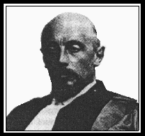The saga
of N-Rays provides a good introduction into experimental design.
It is easy to understand and therefore quite suitable for introductory
general chemistry classes, where it can be discussed in conjunction
with topics such as X-rays.

Figure 1. René Blondlot
René Blondlot was a distinguished professor
of physics at the University of Nancy, France, a corresponding
member of the Academy of Sciences, and the recipient of a number
of scientific awards. Professor Blondlot, while trying to polarize
X-rays which had been recently discovered by Roentgen, claimed
in 1903 to have discovered a new invisible radiation which he
called N-rays (in honor of his home town of Nancy). He used prisms
and lenses made of aluminum to focus and disperse the N-Rays,
and he detected the spectrum by passing a fine thread, coated
with fluorescent material, across the focal plane. His results
were replicated by a number of laboratories. Numerous claims were
made for N-rays, such as they could be conducted along wires,
like electricity.
Blondlot was visited by American spectroscopist
Robert Wood (author of the classic book "Physical Optics",
and discoverer of the phenomenon of atomic fluorescence), who
had tried to duplicate the N-ray experiments, but failed. A number
of experiments were performed in Wood's presence. First, N-rays
were focused on an electric spark and the brightness of the spark
was supposed to increase when the N-rays were present. Wood
saw no effect and was told that his eyes weren't properly sensitized.
Next, Wood was shown several photographs which supposedly
showed a brightening of the spark image, but they were made under
conditions that were subject to a number of errors.
Finally, Wood was shown how the N-rays were refracted
by an aluminum prism in a spectrometer whose entrance slit was
a piece of wet cardboard with a slit cut into it. Wood was suspicious,
because the slit of Blondlot's N-ray spectrometer was 3 mm wide,
yet Blondlot could detect changes in spectral intensity on the
order of 0.1 mm at his focal plane. Wood asked Blondlot to demonstrate
the apparatus, and secretly removed the aluminum prism from the
N-ray spectrometer in the darkened room when Blondlot could not
see him. Yet Blondlot continued to see the N-ray spectrum. Wood
published his results in Nature (Vol 70, p.530, September 29,
1904), and N-rays disappeared from the scientific literature
within several years.
This story has been told many times, and was discussed
by Irving Langmuir as an instance of pathological science in his
1953 lecture that was reprinted in PHYSICS TODAY, Oct 1989,
p. 36. But there's more to the story. There are inconsistencies
between Robert Wood's original article and another published in
1940, and some have claimed that Wood never removed the prism
and this was another one of his pranks.
Sour grapes? Probably, but Wood once used his redoubtable
talents in optics to fabricate what must have been one of the
first photographs of an Unidentified Flying Object (UFO). He has
been described as a showman who long after adolescence was "an
inveterate perpetrator of pranks and hoaxes." But it was
likely Wood's ability to understand the mechanisms of pranks and
hoaxes that led to his unraveling of the N-ray affair. He went
into such a situation with the intent to disprove the effect if
possible, rather than an intent to reproduce the effect. Scientific
research carried out with the latter objective can have disastrous
consequences. Have we seen this recently? How about
polywater and cold fusion. The axiom that we learn most
from our mistakes holds as true in science as it does in any other
form of human endeavor.
One of the best sources of information concerning
Robert Wood and N-Rays is the sociological study of N-rays by
Malcolm Ashmore: The Theatre of the Blind: Starring a Promethean
Prankster, a Phony Phenomenon, a Prism, a Pocket, and a Piece
of Wood, Social Studies of Science, Vol. 23 (1993), 67-106,
which also provides an extensive bibliography.
There are a number of ways that this parable can
be included in the chemistry curriculum. In general chemistry,
it can be a sidelight to a discussion of X-rays and dispersive
spectrometers associated with analysis of crystal structures
and Bragg's law. In more advanced courses, such as instrumental
analysis, the use is obvious.
Contributors:
[Thanks to Professors Marcello Truzzi and Ray Hyman for much of
the information and references on the saga of N-rays]
Page prepared by: Mike Epstein
Last Modified: 30 April 1999